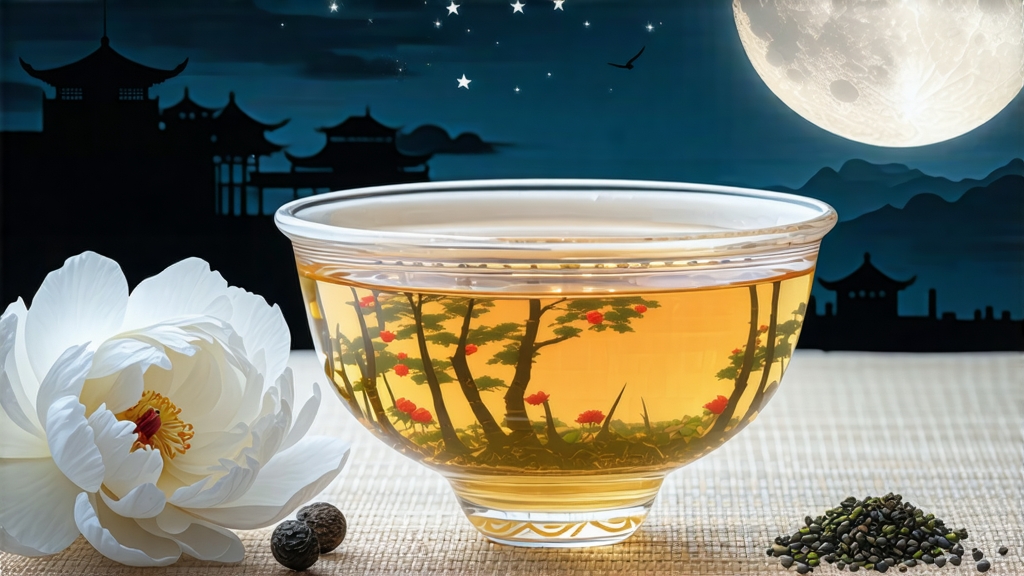
If green tea is the exuberance of spring and pu-erh the wisdom of autumn, then White-Hair Silver Needle (Bai Hao Yin Zhen) is the hush of a moonlit night pressed into a cup. Revered as the aristocrat of Chinese white tea, it consists of nothing but naked buds, each dressed in a silvery duvet so fine that it seems spun by moths rather than grown by a plant. To understand why this minimalist tea commands imperial prices and quiet devotion, one must follow it from myth to mouth, from Tang-dynasty cliff records to the modern glass teapot.
Historical whispers
The first textual wink at white tea appears in the Tang “Classic of Tea” (c. 760 CE), yet those leaves were probably compressed cakes of light-oxidised leaf rather than the bud-only Silver Needle we know. The cultivar itself—Da Bai Hao, “Big White Down”—was documented in Fujian during the Song, but only entered tribute status under the Qing Qianlong Emperor. Legend claims that court ladies collected buds at dawn in April, placing them in silk pouches tucked inside their sleeves so that body heat would start the slow withering before the camellia scent could escape. Whether romance or fact, the image captures the tea’s enduring association with secrecy and softness.
Terroir and cultivar
Authentic Silver Needle is born in two micro-zones: Fuding and Zhenghe, both hugging the subtropical coast of northern Fujian. Fuding’s granitic soils drain quickly, forcing the tea bush to struggle and concentrate amino acids; Zhenghe sits slightly higher, its red loam richer in iron, yielding buds that are plumper and more floral. The permitted cultivars are Da Bai and, in smaller lots, the heart-shaped Da Hao. Only leaf buds—no open leaf, no stem—picked for a scant ten-day window in late March qualify for the name. Pickers work against a spring rain forecast; one shower can swell the bud overnight, turning tomorrow’s treasure into a too-long shoot fit only for lower-grade White Peony.
The craft of doing almost nothing
White tea’s philosophy is restraint. After picking, buds are spread on bamboo trays called “water screens” and left to wither for 36–72 h, during which moisture drops from 75 % to below 10 %. No pan-firing, no rolling, no shaking—only the choreography of air. The key is to stack the trays in arcades that funnel the region’s unique breeze: cool at night, warm by day, scented alternately by orange blossom and ocean brine. Master tea makers read the weather like sailors; if humidity spikes they fire a gentle charcoal pit beneath the corridor, never above 30 °C, just enough to keep the buds from souring. Once withered, the tea rests for a “quiet month” so that residual enzymes flatten any grassiness, then it is charcoal-baked at 40 °C for twenty minutes to fix the aroma. The entire process is a race against mold, yet the slower it goes the more velvety the cup.
Grading the moonlight
Not all silver glitters equally. Top-grade “Imperial Needle” comprises buds 1.5–2 cm long, uniformly ivory with an iron-green stem scar and at least 90 % unbroken tips. When shaken in a porcelain cup they emit a faint bell-like ring, proof of low moisture. Second-grade “Gift Needle” may contain 5 % pale leaflets and allows slight curvature. Anything shorter, browner, or mixed with peony leaf is marketed simply as white tea, not Silver Needle. Ageability is built into the leaf; in Fuding it is said “one-year tea, three-year medicine, seven-year treasure,” and connoisseurs cellar cakes of compressed buds the way Burgundy lovers horde grand cru.
Chemistry in a down jacket
The bud’s velvet is not ornament but armour: trichomes rich in polysaccharides that protect against UV burn. When infused they release trehalose, giving Silver Needle its signature honey note without any actual honey. Because oxidation is halted so early, catechins remain largely unconverted, yielding a liquor lower in tannic bite yet high in theanine and GABA—hence the tea’s reputation for calming rather than stimulating. A 2021 Zhejiang University study found that seven-year